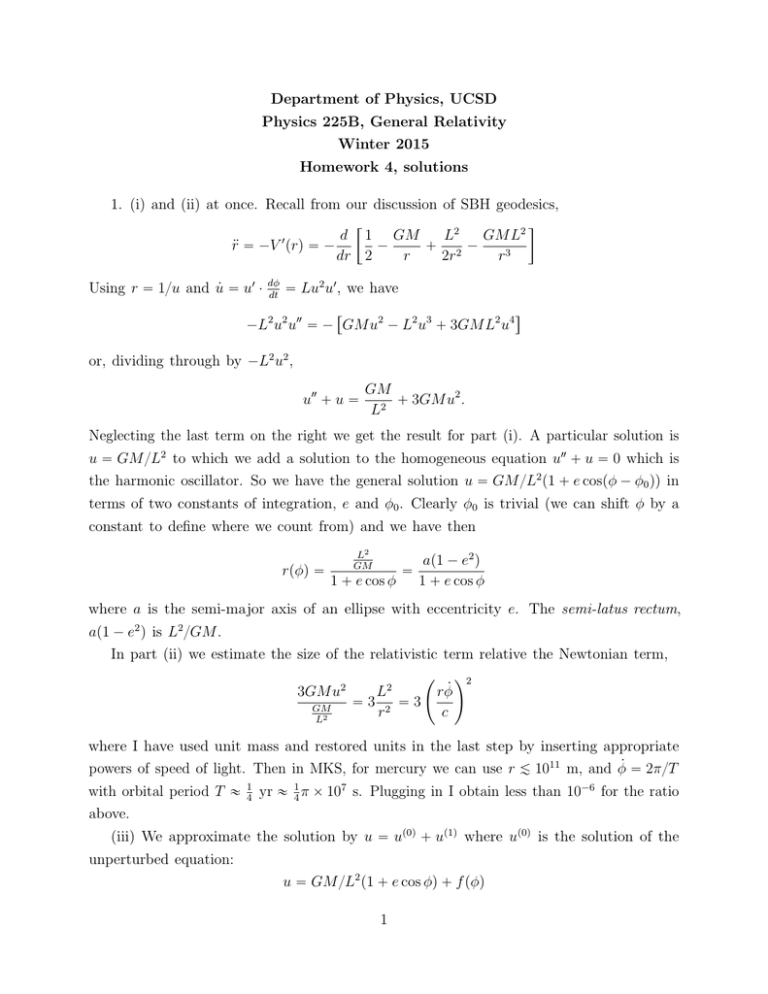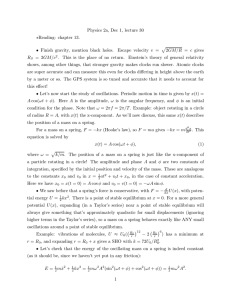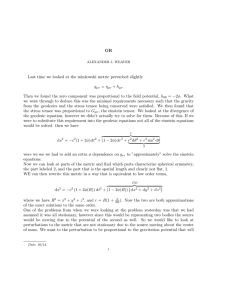Department of Physics, UCSD Physics 225B, General Relativity Winter 2015 Homework 4, solutions
advertisement

Department of Physics, UCSD
Physics 225B, General Relativity
Winter 2015
Homework 4, solutions
1. (i) and (ii) at once. Recall from our discussion of SBH geodesics,
„
d 1 GM
L2
GM L2
1
r: “ ´V prq “ ´
´
` 2´
dr 2
r
2r
r3
Using r “ 1{u and u9 “ u1 ¨
dφ
dt
“ Lu2 u1 , we have
“
‰
´L2 u2 u2 “ ´ GM u2 ´ L2 u3 ` 3GM L2 u4
or, dividing through by ´L2 u2 ,
u2 ` u “
GM
` 3GM u2 .
L2
Neglecting the last term on the right we get the result for part (i). A particular solution is
u “ GM {L2 to which we add a solution to the homogeneous equation u2 ` u “ 0 which is
the harmonic oscillator. So we have the general solution u “ GM {L2 p1 ` e cospφ ´ φ0 qq in
terms of two constants of integration, e and φ0 . Clearly φ0 is trivial (we can shift φ by a
constant to define where we count from) and we have then
rpφq “
L2
GM
1 ` e cos φ
“
ap1 ´ e2 q
1 ` e cos φ
where a is the semi-major axis of an ellipse with eccentricity e. The semi-latus rectum,
ap1 ´ e2 q is L2 {GM .
In part (ii) we estimate the size of the relativistic term relative the Newtonian term,
˜ ¸2
3GM u2
L2
rφ9
“3 2 “3
GM
r
c
L2
where I have used unit mass and restored units in the last step by inserting appropriate
powers of speed of light. Then in MKS, for mercury we can use r À 1011 m, and φ9 “ 2π{T
with orbital period T «
1
4
yr « 14 π ˆ 107 s. Plugging in I obtain less than 10´6 for the ratio
above.
(iii) We approximate the solution by u “ up0q ` up1q where up0q is the solution of the
unperturbed equation:
u “ GM {L2 p1 ` e cos φq ` f pφq
1
and f “ up1q satisfies
f 2 ` f “ κp1 ` e cos φq2
where κ “
3pGM q3
L4
Being a bit lazy I put into Mathematica and obtain
f “ κ ` 12 κe2 ` κeφ sin φ ´ 16 κe2 cosp2φq ` C1 cos φ ` C2 sin φ
with C1,2 constants of integration (and of course, this added to the above gives the solution
for upφq to this order). Note that C1 can be absorbed into e of the unperturbed solution.
This changes the meaning of e in the perturbation by something that is of higher order
than what we are retaining, so we are free to set C1 “ 0. Similarly, the C2 term just rotates
the orientation of the major axes and changes slightly the eccentricity, so we may also set
it to zero. Finally, the constant terms just shift the constant in the unperturbed solution.
(iv) Perihelion (Min distance to focal point) of the unperturbed trajectory is at φ “ 0.
We look for maxima of the function
u “ GM {L2 p1 ` e cos φq ` κeφ sin φ ´ 16 κe2 cosp2φq
Taking one derivative we find a solution (to lowest order) at φ “ 0 and another at
´GM {L2 eφ ` 2πκe “ 0
So the perihelion has shifted in one revolution by
∆φ “
pGM q2
1
2πκe
“
6π
“ 3πp2GM q
2
2
eGM {L
L
ap1 ´ e2 q
Numerics (in SI/MKS units):
∆φ “
6πp6.7 ˆ 10´11 qp2.0 ˆ 1030 q
“ 5.1 ˆ 10´7 rad
p5.8 ˆ 1010 p1 ´ p0.21q2 qc2
To change this into per century we have to multiply the number of revolutions in a century,
and since the orbital period is 0.24 yr, we have
revs per century “ 100{0.24 “ 417
So the shift per century is 2.1 ˆ 10´4 radians, or (times 360 ˆ 602 {2π) 43 arcsec per century.
2. From class we have that for a null geodesic in the SBH metric
ˆ ˙2
ˆ
˙
1 dr
1
2GM L2
1
`
1´
“ E2
2
2
2 dλ
2
r
r
2
2
where L “ r2 dφ{dλ.
As in the previous problem introduce u “ 1{r and dr{dλ “
´u´2 u1 dφ{dλ “ ´Lu1 , so that
pLu1 q2 ` L2 u2 p1 ´ 2GM uq “ E 2
It is convenient to differentiate this, to put it in the same form as in the previous problem
(you could of course just integrate the above):
u2 ` u “ 3GM u2
The right hand side is a small quantity for the sun:
3GM u2
GM
«
„ 10´6
u
Rsun
Neglecting the right hand side we have a straight path,
up0q “ b´1 sin φ
where b is the impact parameter. Using this as the zeroth order approximation in teh
perturbative solution gives
3GM
sin2 φ
b2
which has a solution f “ p3GM {2b2 qp1 ` 1{3 cos 2φq giving the solution
ˆ
˙
3GM
1
´1
u “ b sin φ ` 2
1 ` cos 2φ
b
3
f2 ` f “
For large r (small u) φ is small modulo π. Taking the small solution, as u Ñ 0 we have
φ Ñ φin with
2GM
b
and the total deflection ∆ is twice (the absolute value of) this,
φin “ ´
∆“
4GM
b
Closest approach is at φ “ π{2 or
1{r0 “ u0 “
1 GM
` 2
b
b
or
r0 « b ´ GM.
The largest deflection is for b « r0 “ rsun , the radius of the sun. Plugging in
∆max “ 4
p6.7 ˆ 10´11 qp2.0 ˆ 1030 q
“ 8.51 ˆ 10´6 rad “ 1.75 arc sec
p7.0 ˆ 108 qc2
3
3. We want to solve the equation
Gµν “ ´Λgµν
or equivalently
Rµν “ Λgµν
Moreover we are instructed to assume a spherical symmetric static metric. That is
ds2 “ ´T prqdt2 ` Rprqdr2 ` r2 dΩ22
On chap 5, p.3 of my class notes you will find the Ricci tensor for this metric (this was
used in connection with the RN BH). The Rtt equation is
1 T 2 1 T 1 R1 1 T 12
1 T1
´
´
`
“ ´ΛT
2R
4 R2
4 RT
rR
As in every static case we try a solution with RT “ 1. This gives
2
T 2 ` T 1 ´ 2Λ “ 0
r
d
This is easy to solve (using r´2 dr
pr2 T q “ T 2 ` 2r T 1 and integrating twice):
1 1
T “ C1 ` C2 ´ Λr2
r 3
Now we can fix the constants of integration as follows. C1 “ 1 is necessary for solving the
Rθθ equation. You could guess it from setting Λ “ 0 and requiring this gives a SBH. In fact
this is what we do to interpret (cheaply) the second constant, which we set to C2 “ ´2GM .
So we have
2GM
1
1
“1´
´ Λr2
R
r
3
It is straightforward to check that the other component of Einstein’s equations are satisfied.
T “
(ii) For M “ 0 the metric is
ds2 “ ´p1 ´ 31 Λr2 qdt2 ` p1 ´ 31 Λr2 q´1 dr2 ` r2 dΩ22
We know this should be dS or AdS, depending on the sign of Λ, but looks unfamiliar. We
could simply check that the Riemann tensor satisfies the condition ofr maximal symmetry.
But more interesting is to display a change of coordinates that relates this to one of our
known versions of the metric. Or beter yet, to derive this static metric form the embedding
in 5D. Recall, dS is the 4D hypersurface
´u2 ` w2 ` x2 ` y 2 ` z 2 “ α2
4
in 5D flat Lorentzian space, ds2 “ ´du2 ` dw2 ` dx2 ` dy 2 ` dz 2 . The obvious thing to try
in going to spherical symmetry is spherical coordinates for x, y, z, so that
´u2 ` w2 “ α2 ´ r2
Then we need to choose one more coordinate form u and w and solve for the last. But we
do not want square roots. So we go to lightcone coordinates, w˘ “ w ˘ u. We choose then
α2 ´ r 2
w` “
w´
Finally, since w´ will now appear in the metric as dw´ {w´ we introduce ξ “ ln w´ so that
ds2 “ ´pα2 ´ r2 qdξ 2 ´ 2r dr dξ ` dr2 ` r2 dΩ22
ˆ
˙
r
2
2
2
“ ´pα ´ r q dξ ´ 2 2
dr dξ ` dr2 ` r2 dΩ22
α ´ r2
Now, let
r
dr
´ r2
which can be obtained explicitly by integration, but we will not need. Then
dR “
α2
`
˘
ds2 “ ´pα2 ´ r2 q dξ 2 ´ 2dR dξ ` dr2 ` r2 dΩ22
“ ´pα2 ´ r2 q pdξ ´ dRq2 ` pα2 ´ r2 qdR2 ` dr2 ` r2 dΩ22
ˆ
˙2
r
2
2 1
2
2
2
“ ´pα ´ r q 2 dt ` pα ´ r q
dr ` dr2 ` r2 dΩ22
α
α2 ´ r 2
“ ´p1 ´ r2 {α2 qdt2 `
α2
dr2 ` r2 dΩ22
α2 ´ r 2
In going from the second to the third line we have defined t “ αpξ ´ Rq. Identifying
Λ “ 3{α2 we see this is the M “ 0 limit of the BH metric above. Note that Λ ą 0
necessarily, since α2 ą 0. A similar computation can be made for the AdS case.
Killing horizon: we are looking for a solution to gtt “ 0. That is T prΛ q “ 0 or
1´
2GM
1
´ ΛrΛ2 “ 0
rΛ
3
For Λ ą 0 there are generically zero or two solutions, while for Λ ă 0 there is always one
solution.
(iii) As instructed
ds2 “ T prqdτ 2 ` T prq´1 dr2 ` r2 dΩ22
5
Now, let r “ rΛ ` q, so that T prq “ T 1 prΛ qq ` ¨ ¨ ¨ . Now the point is that
T
´1
?
dq 2
dr „
“ 4pd qq2 “ du2
q
2
?
?
where u “ 2 q “ 2 r ´ rΛ . The metric near rΛ is now
2
ds2 “ u2 dτ 2 ` du2 ` rH
dΩ2
The first two terms tell the story. u is only defined for u ą 0 so it is a radial coordinate
and du2 ` u2 dτ 2 is precisely of the form of polar coordinates, and defines a regular space if
τ (the polar coordinate) is periodic mod 2π.
µ
4. First generalities/review: The observer moves on a time-like geodesic, gµν dx
dτ
dxν
dτ
“ ´1.
For the RN-BH with mass M , electric charge Q and zero magnetic charge,
ds2 “ ´T prqdt2 ` T prq´1 dr2 ` r2 dΩ22 ,
T prq “ 1 ´
4πGQ2
2GM
`
r
r2
we can take the geodesic to be on the θ “ π{2 (equatorial) plane with conserved quantities
(from the two Killing vectors ~Bt and ~Bφ ):
E “ ´gtt
dt
dt
“ T prq
dτ
dτ
and
L “ gφφ
dφ
dφ
“ r2
dτ
dτ
Using this and the fact that on a circular orbit r “ constant we have
E2
L2
´1 “ ´
` 2
T prq
r
.
The circumference, a given, C “ 2πr gives r and therefore we have a relation between E
and L. To fix them both we need in addition to require that r: “ 0, that is, that the effective
potential energy is minimized at this value of r. This is just as in classical mechanics. I
will not carry out the computation, and give only implicit results in what follows. The
instantaneous velocity of the observer has magnitude
β“r
dφ
L{r
“
dt
E{T prq
and obviously is tangential to the circle.
At any point on the circular trajectory the observer has some tangential velocity β~ and
~ Therefore the observer
observes, instantaneously, the charged BH moving with velocity ´β.
sees a current in the direction of ´β~ which produces a magnetic field transverse to the
6
plane of the orbit: if the circulation is couter-clockwise as seen from above the plane of the
orbit then the magnetic field points up.
To compute the field we take the field of the BH, Er “ Q{r2 and Br “ 0 and boost it
to a frame for which the observer is instantaneously at rest. It is simplest to use cartesian
coordinates: instantaneously we can take the motion of the observer (in the rest frame of
the BH) to be in the x-direction, the direction towards the BH to be ´z, so that z is the
radial direction. Then y points up from the plane of the orbit. Boosting the electric field
a
1
strength Fµν
“ Λµ ρ Λν σ Fρσ along the x-axis, Λ0 0 “ Λ1 1 “ γ “ 1{ 1 ´ β 2 , Λ0 1 “ Λ1 0 “ ´βγ,
we have
1
F13
“ Λ1 µ Λ3 ν Fµν “ ´βγF03
so that the magnitude of the magnetic field pointing up is
βγEr
with β, γ and Er given above.
7



